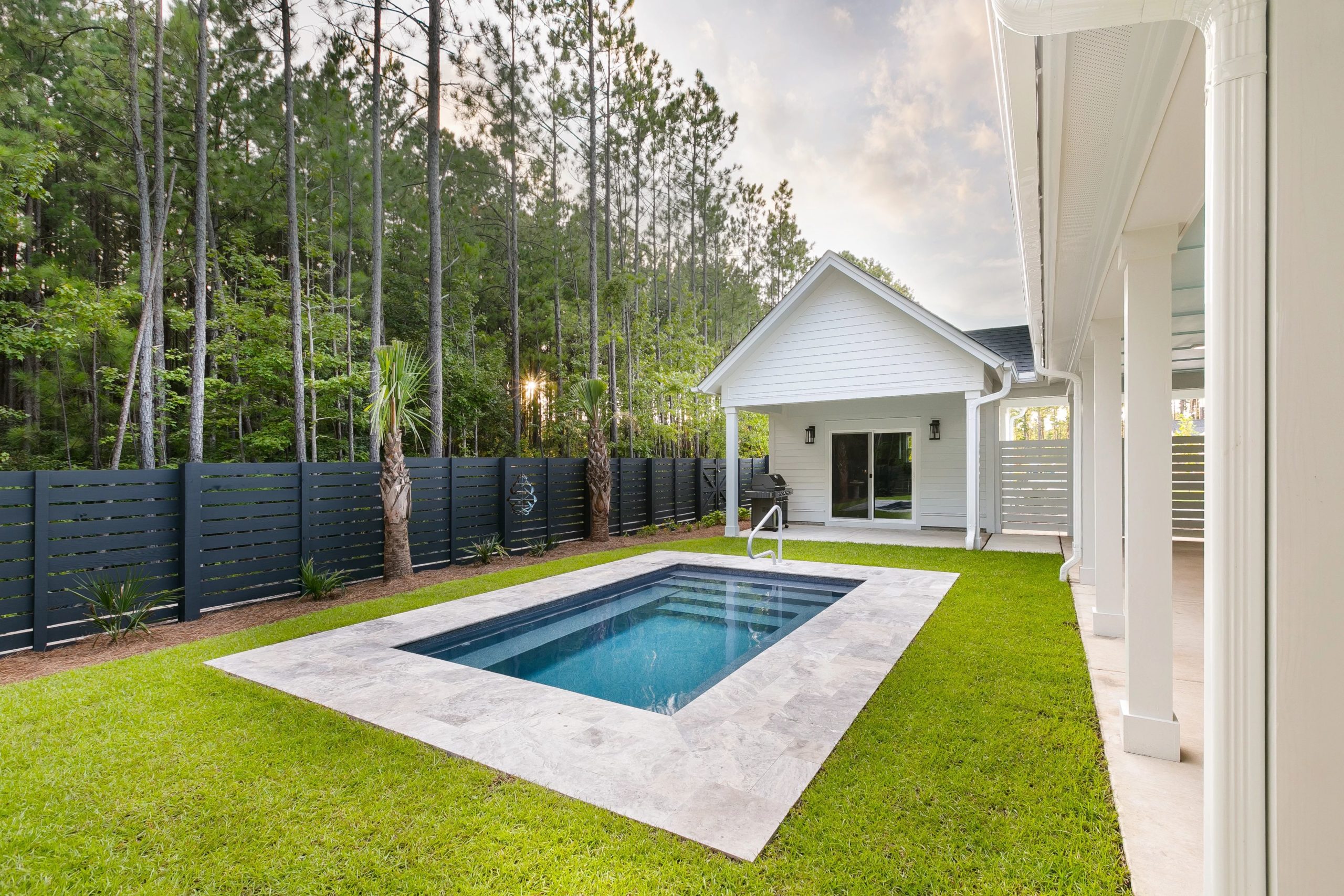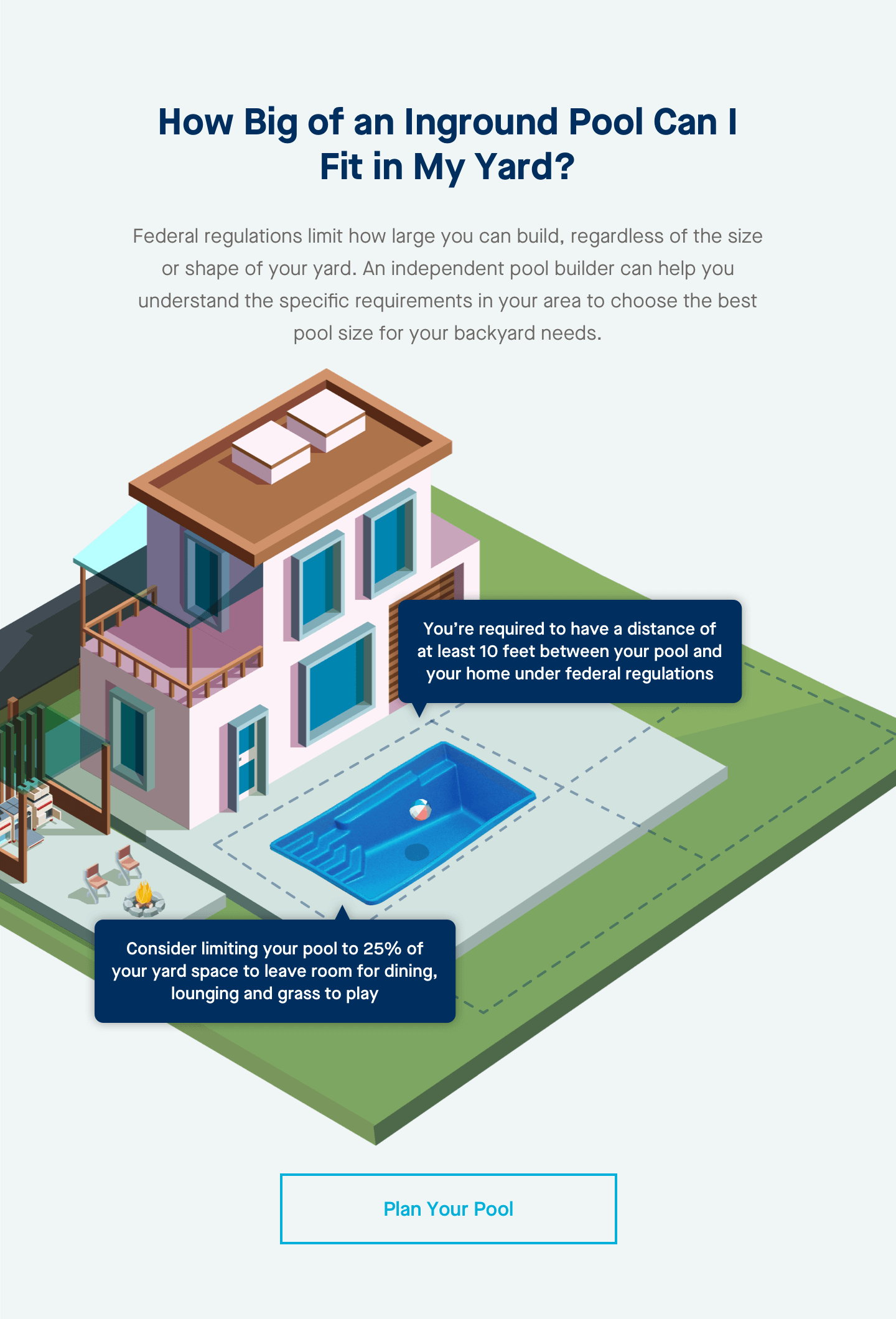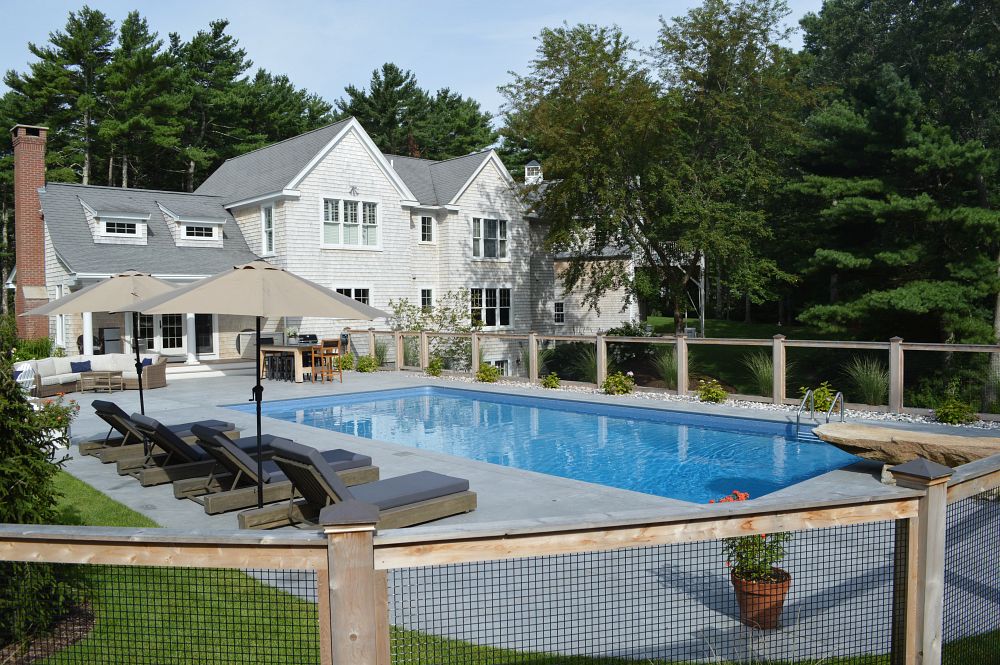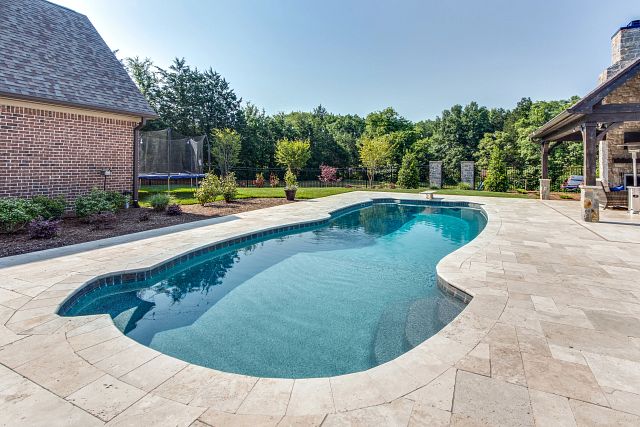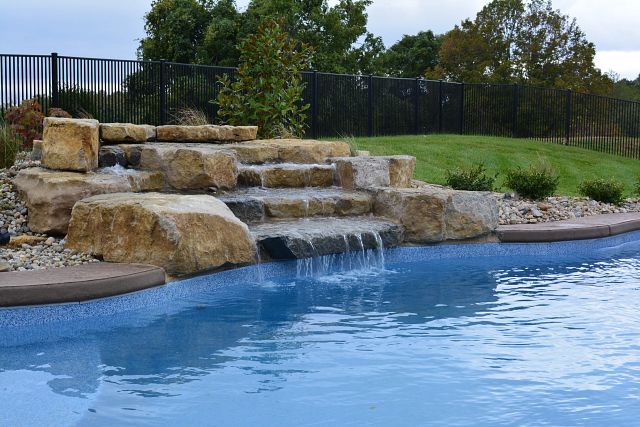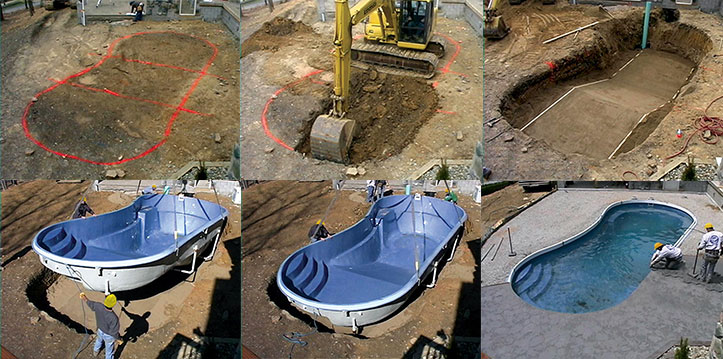Summer is just around the corner, and it’s the perfect time to start thinking about installing a small in-ground swimming pool. While many homeowners dream about having their own personal oasis to share with family and friends, those with smaller backyards may feel as though it’s an unattainable dream. If this has been a concern of yours, we’ve got great news: no matter how compact your space is, there’s a way for you to enjoy some fun in the sun and water. The flexible designs, shapes, and sizes of a fiberglass or vinyl liner pool make it possible for you to design a gorgeous centerpiece for your property.
In this guide, we’ll answer some of your most frequently asked questions about small inground swimming pools, from minimum space requirements to the most popular pool shapes for compact yards. And if you still have questions, the expert team at Latham is here to help. Not only can we provide you with answers to all your FAQs, but our custom-made swimming pools can also be crafted to meet your unique specifications, delivering superior quality and durability at any price point. With value-adding features like lights, steps, tanning ledges and more, you can truly design the swimming pool of your dreams — even with limited space.
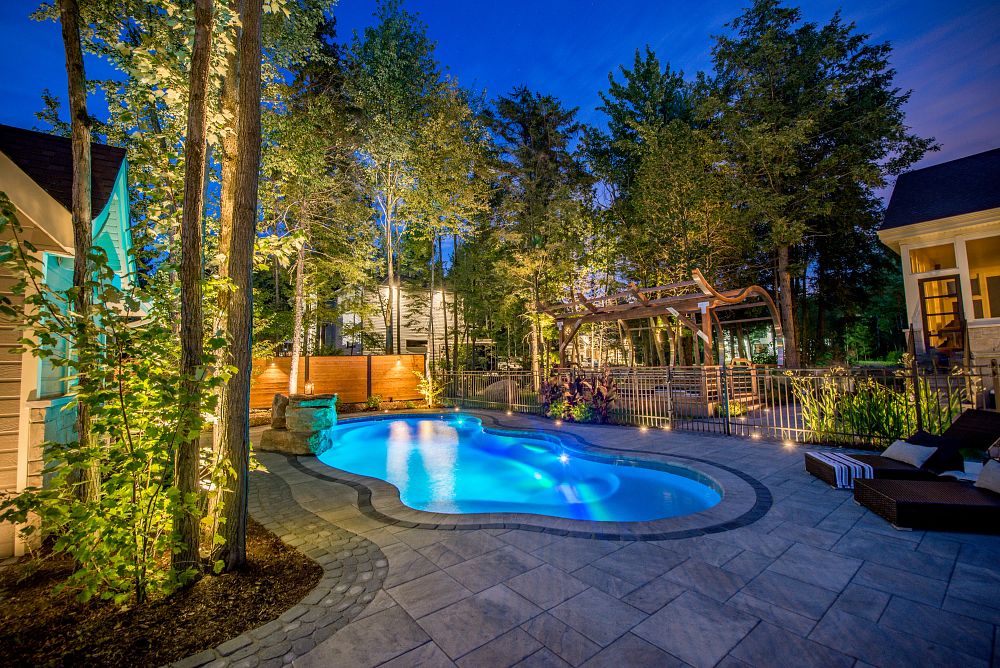
What Is Considered A Small Inground Pool?
The average size inground swimming pool is larger than 600 square feet. A small, or ‘boutique’ swimming pool is typically considered to be one that is 600 square feet or less. Depending on the shape, size, and design, a small inground swimming pool could still be used for aquatic exercise, as well as purely for recreation. While waterfalls and other water features may be incorporated into a smaller-scale swimming area, diving is not recommended. A small pool will usually be no more than 5 or 6 feet deep. This ensures that homeowners get the most usable space out of their pools.
Common Dimensions for Small Inground Pools
The average size of a small inground pool is 10’ x 20’, however, there are small-sized pools that can be slightly larger or even smaller than this average. For instance, cocktail pools and plunge pools are two ultra compact types of pools that have been gaining in popularity in recent years – especially among those in densely populated neighborhoods with smaller yards. Cocktail and plunge pools range in size, but typically sit within the 10’ x 16’ range with a more shallow 4’ depth.
If you’re planning to add a pool to your backyard, here are some common smaller pool dimensions to consider:
- 8’ x 24’
- 9’ x 17’
- 10’ x 16’
- 10’ x 20’
- 11’ x 22’
- 12’ x 14’
- 12’ x 24’
- 12’ x 25
- 12’ x 26’
- 12’ x 27’
- 13’ x 24’
- 14’ x 28’
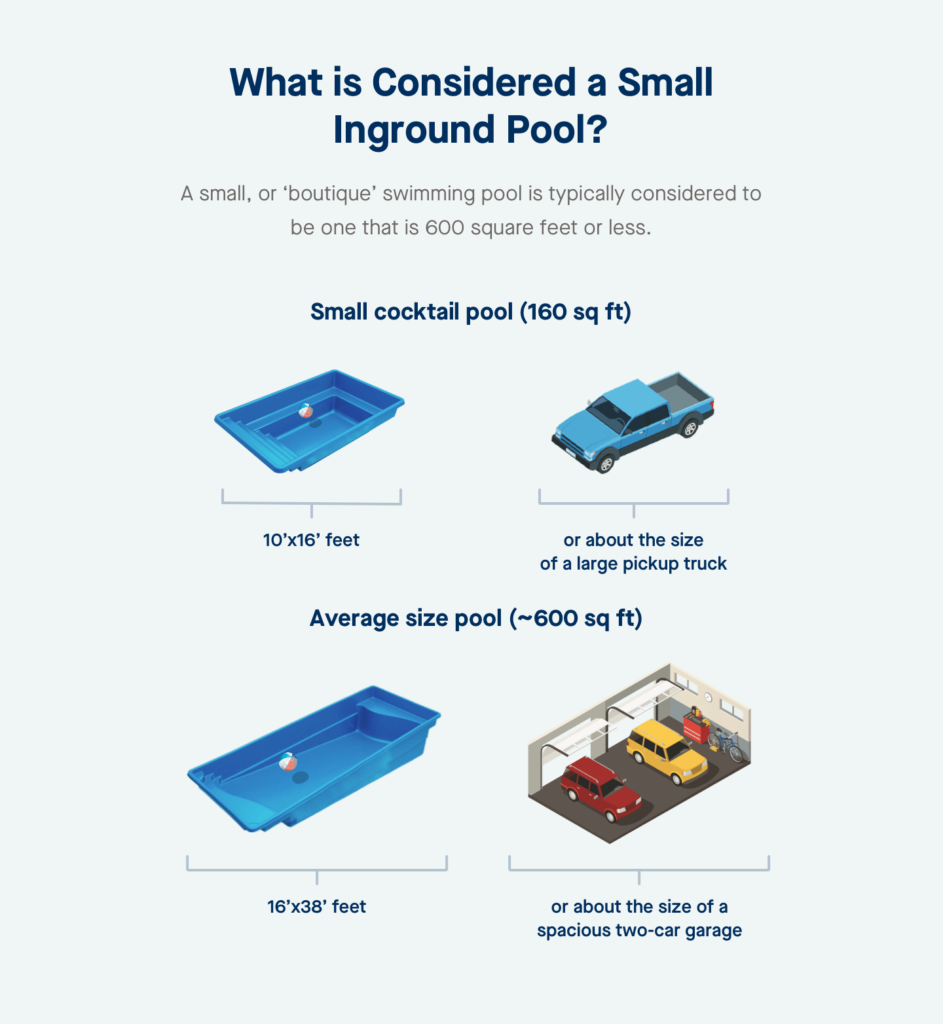
How to Know If Your Small Inground Pool is Big Enough
You may hear the phrase “go big or go home!” kicked around a lot. However, small-sized pools can still offer significant bang for your buck, giving you ample space for entertaining or using your pool for exercise. Ultimately, it’s not about the size of your pool, but the enjoyment it can offer and how well it fits within your backyard, complementing your home and yard. You’ll also want to consider how you plan to use your pool.
Small Pool Sizes for Personal & Family Use
If you want to use your pool for relaxation, with only family and a handful of friends occasionally dropping by, you can confidently consider more compact options like a cocktail pool or a plunge pool.
Similarly, if you’re planning to use your pool primarily for exercise, most lap pool sizes have a length of 40’ x 50’, which is much larger than most “small” pools. Considering that you might not be training for the Olympics, a smaller-sized pool with a 20’ to 28’ length can be great for squeezing in a water-based workout for beginners or more advanced swimmers.
Calculating Appropriate Pool Size for Hosting Pool Parties
However, if you’re planning on hosting pool parties for friends and family – and your kids’ friends – you’ll want to consider the total surface area of your pool to comfortably accommodate the whole gang.
The total surface area is equivalent to your pool’s length x width. For instance, if you have a 12’ x 25’ pool, its total surface area is 300 feet. Similarly, if you have a 9’ x 16’ pool, its total surface area is 144 feet.
To determine whether your pool is “big enough” to host everyone, consider that you’ll need an average of 15 square feet for each person in the pool. (Exceeding this recommendation can make for cramped accommodations and can be potentially unsanitary.)
If you’re a family of four and you invite 4 friends, and your kids invite a total of 6 pals, that’s potentially 14 people who may be using your pool at the same time. Using the formula of 15 square feet per person, you’ll need a square footage of 210 feet for everyone to have plenty of space in your pool:
Total # of people x 15 square feet per person = total surface area minimum
14 people x 15 square feet per person = 210 square feet
If you have a 12’ x 25’ pool, it has a total surface area of 300 feet. You’re in the clear with plenty of room for you and your guests to splash and play – well under the recommended minimum of 15 square feet per person.
How Small is Too Small for a Pool?
It’s important to find the right balance and avoid building too small. For instance, if your pool is not deep enough, it could be difficult for you to swim comfortably, which may prevent you from being able to exercise in the pool. If you intend to swim laps, you will generally need a minimum depth of 4 to 5 feet, versus a minimum depth of around 3 feet for floating or soaking.
Similarly, if you plan to use your pool for hosting get-togethers, you’ll also want to consider square footage. There can be such a thing as a pool that’s too small for your intended use.
Using our example and calculations for the recommended total surface area minimum, (based on 15 square feet per person), let’s look at what would happen if you had a total of 14 people at your party and had an 8’ x 15’ pool.
With an 8’ x 15’ pool, your pool’s total surface area is only 120 square feet. This will not be able to support the recommended minimum (210 square feet) if all 14 people are in the pool at the same time.
In fact, if you’re operating from the calculation mentioned previously, using 15 square feet per person, a pool with 120 square foot surface area will only be able to accommodate 8 people at the same time.
To paraphrase Quint from Jaws, “You’re gonna need a bigger pool.”
While you can “police” your pool to only ensure that only 8 people are using the pool at the same time, that won’t be a lot of fun for you and your guests. So, consider investing in a slightly larger pool, pending your available backyard space.
To get the most enjoyment — and the best value — out of your new backyard investment, you should talk to a pool installation professional, who can help you use your space efficiently without sacrificing comfort or fun. As we’ve explored, there are many small inground pool options that are perfect for compact yards, such as our Jamaica and Milan models. Depending on which design styles you prefer, whether you’d like the pool to feature seating, the shape of your yard, and other factors, our expert team can provide you with detailed sizing recommendations.
What Size Pool is Best for a Small Backyard?
Many homeowners want to know, “Can you put an inground pool in a small backyard?” The answer is absolutely yes! As you might be surprised to learn, as little as 1,200 square feet of backyard space provides enough room to install a stunning pool. Not only is it possible to install a pool in a small yard, but with today’s innovative technology, there are more small pool design options than ever before to choose from.
Several common, smaller pool sizes and dimensions can nestle comfortably into a smaller backyard, including 9’ x 16’, 10’ x 20’, 12’ x 25’ or even larger models like a 14’ x 48’. Be sure to carefully measure the length and width of your yard, taking into account the area you may want to reserve for decking, an outdoor grilling station, or a smaller patch devoted to a vegetable or flower garden.
We’ll talk about those design options in a moment — but before we go over the aesthetic possibilities, it’s important to review some basic safety considerations. For example, in order to ensure safe installation and use of your pool, you’ll need to select a model that isn’t too large, small, shallow or deep. You’ll also need to calculate the dimensions of your yard, plus the access area where the pool will be installed, which plays a role in determining how large of a pool you can build safely.
Before putting in a small inground pool, we strongly recommend discussing your construction needs with a pool expert, or using one of Latham’s trusted apps for pool owners, such as our AR Pool Visualizer Application. We’ll also discuss yard and pool sizes in detail later on in this guide, providing you with additional information about how to plan your pool safely. For now, let’s take a look at some of the most popular shapes for small inground swimming pools.
What Shape Is Best For a Small Swimming Pool?
Because every backyard is different, there’s no black and white answer to what pool shape is best for a small yard. While some may dislike the fact that curvier kidney-shaped pools lose some water space, others love that this allows for more decking space for lounge chairs and patio furniture. Working with a design specialist to assess your property and demands will enable you to come to the right solution for your home. However, there are some fiberglass pool shapes and designs that easily lend to being used in a small backyard.
Small Backyard Pool Designs
Limited space doesn’t have to limit your design options. From classic to modern, there’s a wide range of looks and styles available for small inground pools. But how should you choose the best style to meet your needs and specifications? For example, what style is best if you want to swim laps? Keep reading to learn about three of our most popular small pool design options, including cocktail pools, freeform pools and lap pools.
Cocktail Pool
The cocktail pool, also known as a plunge pool, is essentially just a tiny version of the traditional backyard swimming pool. These come in a variety of shapes and sizes, though you usually find them in rectangular forms. The cocktail pool is a great option for the homeowner with a small yard who just wants to be able to take a dip.
Latham released a fiberglass design for a cocktail pool in 2018. This pool measures 10′ by 16’ with a depth of 4’. It has built-in benches on 3 sides and stairs on the fourth. It’s a great way to add a shimmering centerpiece to a small backyard.
Cocktail pools are mostly for leisure, for having a soak on a hot day or bringing a few friends over for a pool party. For those who want a backyard pool for exercise or therapeutic reasons, then you may want to check out our next kind of pool.
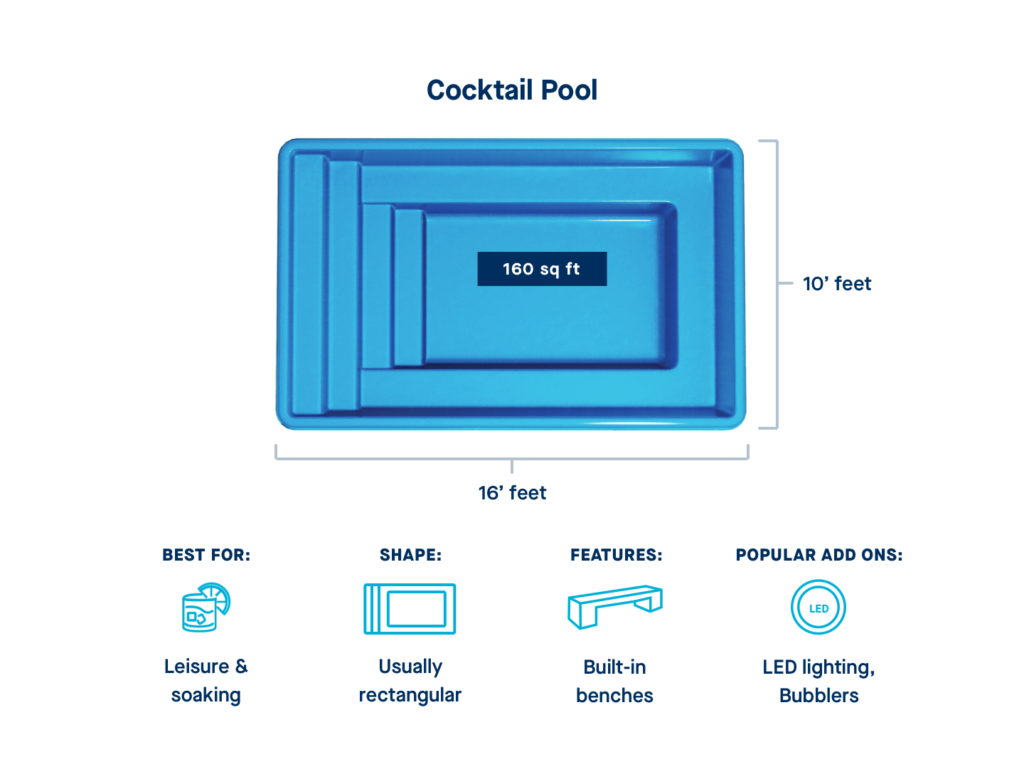
Explore Latham’s Most Popular Cocktail Pool Options:
- Fiberglass: Milan Model
- Vinyl Liner: Patrician Model
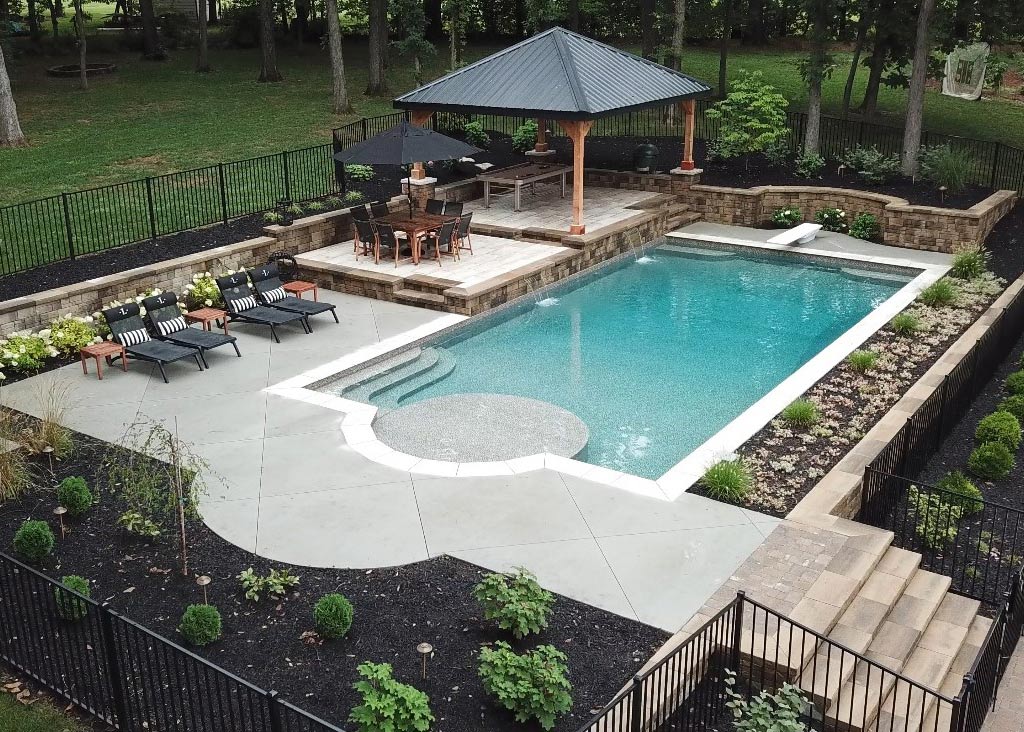
Freeform
Freeform pools are popular designs for smaller backyards. Their curvilinear designs actually pack more swimming area into less perimeter footage than a rectangular pool. Also, these eye-catching shapes offer a bunch of different options for decking around the pool. Latham manufactures several small freeform fiberglass shapes that are perfect for smaller yards. Our smallest kidney-shaped design takes up less than 150 square feet of space.
Some freeform designs aren’t great for lap swimming, so keep that in mind when you’re choosing or designing your own backyard pool. However, they do offer many places for seating, and the curves of the design lend themselves to the addition of decorative water features or a spillover spa (if you have the room).
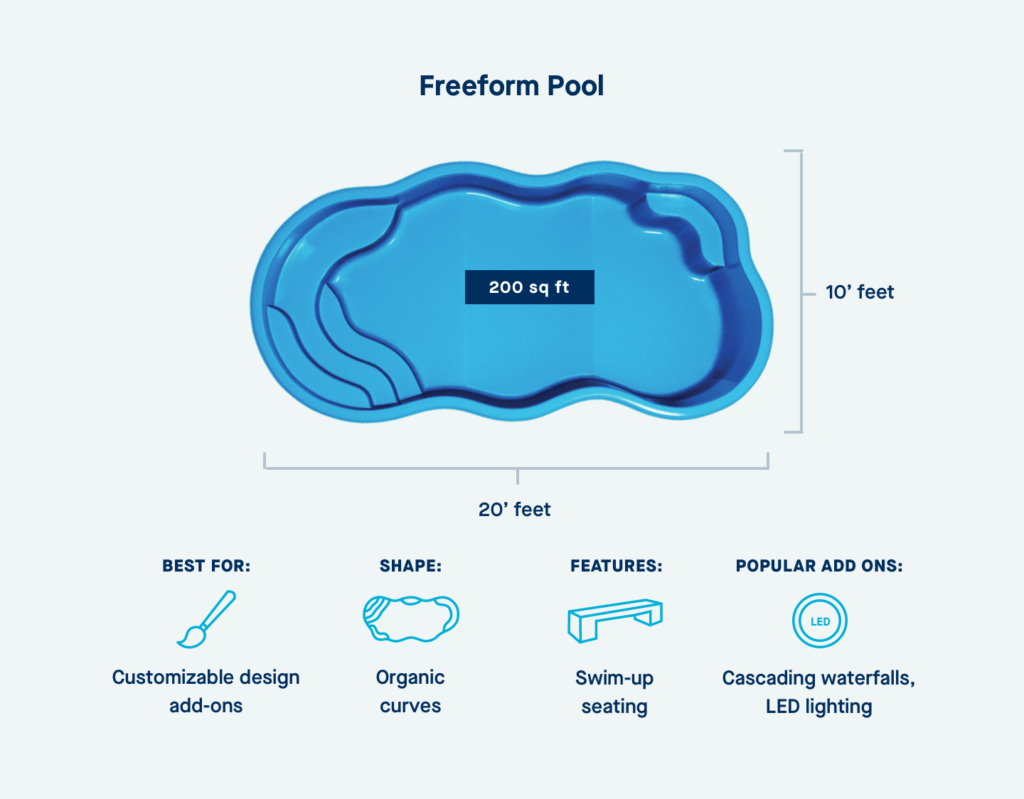
Explore Latham’s Most Popular Freeform Pool Options:
- Fiberglass: Fiji Model
- Vinyl Liner: Taormina Model
Lap Pool
Although lap pools can be rather long, a shorter design might be just what you are looking for in a small backyard pool. Lap pools tend to be relatively narrow (our fiberglass offerings are 12′ wide) and come in a variety of lengths. A 24′ by 12′ lap pool offers plenty of room to swim laps without exceeding 300 square feet.
If you want a pool for exercise purposes the lap pool is a great design, especially if you don’t want all the extra bells and whistles you get with a swim spa. Again, these do have to be a little longer than the other designs on the list, but on the right plot of land a small lap pool is an excellent option.
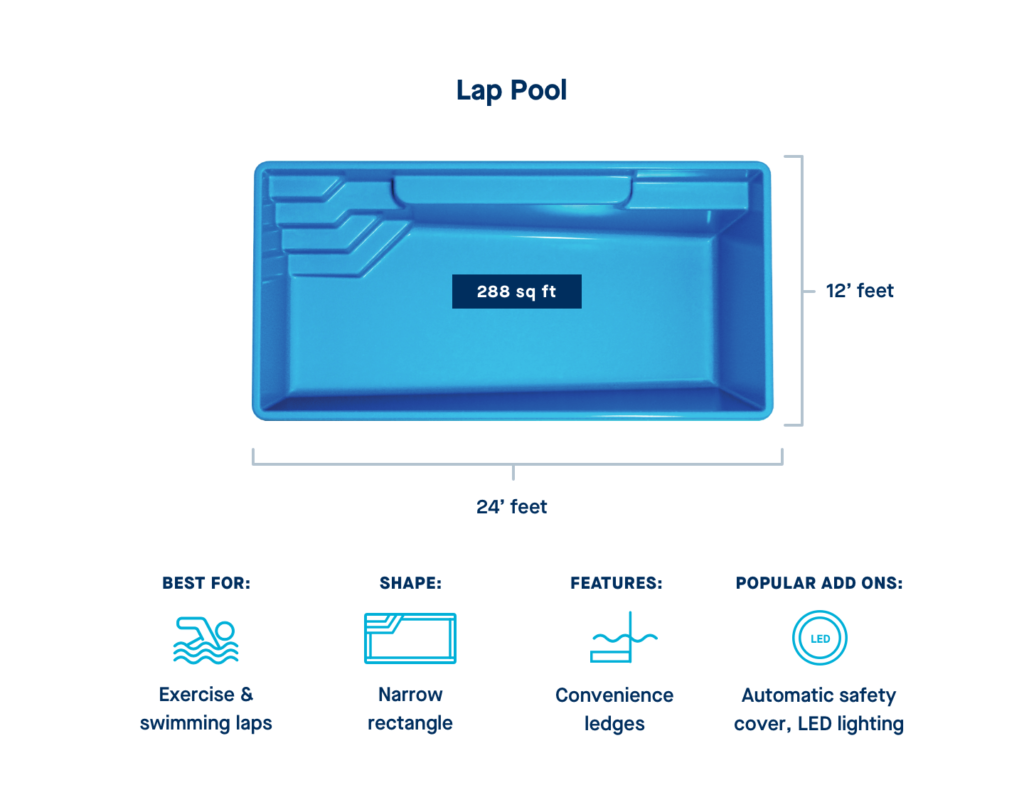
Explore Latham’s Most Popular Lap Pool Options:
- Fiberglass: Sirius Model
- Vinyl Liner: Rectangle Model
Small Inground Pools FAQ
Now that we’ve compared some of our most popular pool shapes and looked at the benefits of each, let’s go over some factors you’ll need to consider before installing your pool, such as the size of your yard or whether to choose vinyl instead of fiberglass. In this section, we’ll answer your most commonly asked questions about small inground swimming pools, including:
- What type of pool is best for a small yard?
- How small (or large) can an inground pool be?
- How much yard space do I need to install a pool?
- What other factors should I think about when designing and installing a small swimming pool?
Are Small Inground Pools Easier to Maintain?
One of the perks of a smaller inground pool is that it can be easier to clean and maintain. Smaller pools have less surface area that you’ll need to skim weekly. If you have a vinyl liner pool, one of the most common maintenance tasks is to give your liner a gentle scrubbing with a soft-bristled brush to keep dirt and stains at bay. A smaller pool means less pool to clean!
Are Small Inground Swimming Pools Cheaper to Maintain?
Owning a small inground swimming pool can mean cheaper maintenance costs overall.
- Reduced water heating costs: If you love the feel of warm water, plan to use your pool at night, or want to extend your pool season into fall, a water heater can help you maximize your enjoyment. A smaller pool means a lower volume of water to heat, translating to lower costs.
- Reduced chemical usage: Owning a pool means balancing your water pH and chemistry on a regular basis. Smaller pools need fewer chemicals and less chlorine to balance your water, reducing maintenance costs.
- Reduced energy costs: A smaller pool means that your filtration system does not have as heavy a volume of water to cycle through. Again, this translates to lower routine maintenance costs.
- Less-expensive surface area for upkeep: If you need to swap out your liner, re-grout or tile your pool, a smaller pool means a smaller surface area to refurbish, keeping it beautiful for years to come.
- Lower cost to refill your pool: Whether it’s lowering your water levels to close your pool for the season or removing water in order to make repairs, every pool owner will need to refill their pool at some point. A smaller pool means you’ll save more on the cost to refill it.
In addition to the size of your pool, the type of material used to construct your pool can also play a role in reducing the cost to maintain your pool. Both fiberglass and vinyl liner pools are less expensive in terms of upkeep compared to concrete or gunite pools. Concrete pools, due to their porous surface, will require resurfacing every 10 years or so. Even a smaller concrete pool can rack up quite an expensive tab over its lifetime when compared to a smaller maintenance bill for fiberglass or vinyl.
What Considerations Should Be Made For My Pool?
Before planning the layout for your swimming pool, it’s important to discuss your preferences with your local pool builder. Be sure to evaluate how much time you and your family anticipate spending in and around the pool, and how important it is that you have a grassy area within your yard where the kids are able to run and kick a soccer ball around. These types of things can help your designer to determine how the swimming pool should be laid out, what size restrictions there may be, and how to best optimize your landscape so that it’s tailor-fitted to suit your every whim.
What’s The Best Type Of Pool For A Small Yard?
Having the ability to play around with different shapes is crucial to maximizing your space for a small swimming pool. A fiberglass pool is a great option because there are so many different shape, size and design combinations available. Even if you’ve got an oddly shaped backyard, you can make it work! Fiberglass also enables you to get multiple uses out of your pool. In addition to keeping you cool, you can also add waterfalls, streams, and spillways that allow it to double as an attractive water feature, or even build in a tanning ledge to save more space.
How Small Can You Get an Inground Pool?
The minimum size for an inground pool depends, in part, on the shape and style you select. For example, the smallest dimensions that we generally recommend for a kidney-shaped pool, like our dazzling Jamaica model, are approximately 10′ x 20′ with a minimum depth of 3’2″ to 5′ — small enough to fit in almost any outdoor space, but large enough to let you and your loved ones enjoy the pool safely and comfortably. Small in size but big on fun, the compact Jamaica occupies less than 200 square feet of space. Other typical size options for small pools include:
- 8’ x 24’
- 9’ x 17’
- 10’ x 16’
- 10’ x 20’
- 11’ x 22’
- 12’ x 14’
- 12’ x 24’
- 12’ x 25
- 12’ x 26’
- 12’ x 27’
- 13’ x 24’
- 14’ x 28’
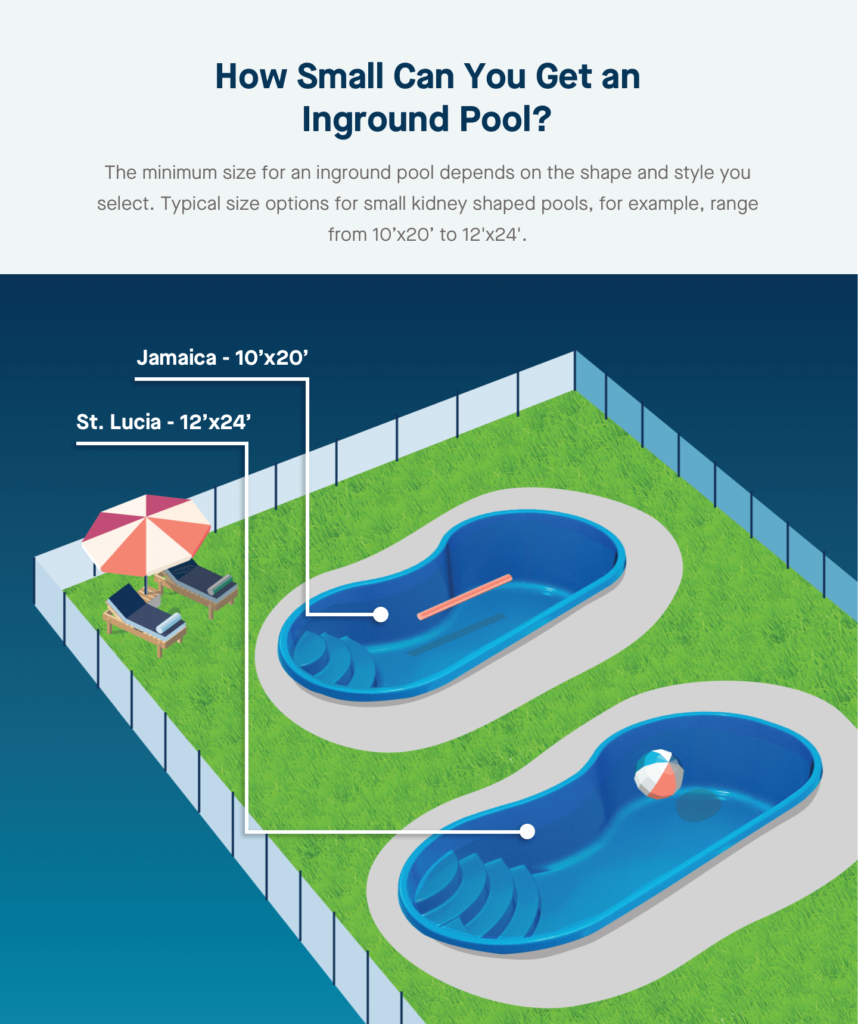
To explore more space-saving ideas, check out our Backyard Style Book or Pool Shapes Hub, where you’ll find design specs, image galleries, and other helpful tips to help you create your ideal look.
How Long Does It Take to Install a Small Inground Pool?
The total time to install a small pool varies based on a number of factors. Overall, it may take less time to install a smaller pool since they aren’t as deep as larger pools and take up less surface space. However, here are a few factors to keep in mind that may impact the time frame to install a smaller pool:
- Material: Vinyl liner pools can take several weeks to install, as they require pool builders to excavate a spot in your yard and pour your pool into place, then apply and seal your liner before filling. Fiberglass pools can be installed in as little as three days after a space has been excavated in your backyard. Because fiberglass pool shells are pre-manufactured and transported to your backyard, it speeds the time towards completing your pool project.
- Add-ons: Some add-on features can tack on extra time to your pool installation process, even for a small pool. For instance, if you want to install water features or LED pool lights, you may need an electrician or plumber to configure circuitry and/or water lines for these features to work their magic.
- Weather and seasonality: If you’re starting your pool project during a period of peak volume and builders have a backlog of installations, that may also factor into how long it will take to install a small (or large) pool. Similarly, weather such as snow, ice, or even rain can also delay your project. Cold weather may make the ground too hard to excavate, while rain can create messy mud puddles that can make installation more difficult.
- Uneven or sloped terrain: Even small yards aren’t immune to uneven ground or rocky terrain lurking beneath the soil. This can also add more time to installing a small pool. A knowledgeable builder will be versed in a variety of techniques to make your ground more hospitable to a pool.
Can You Install A Slide Or Diving Board In A Small Inground Pool?
Even a small pool can have the fun factor of a thrilling water park – right in your own backyard. Adding a slide to your small inground pool can up the ante in terms of fun. Slides can be installed on pools that are at least 3 feet deep. Considering that most smaller pools fit that minimum, you can safely install a water slide in your small fiberglass or vinyl liner pool. If your pool has a shallow wading area that’s less than 3 feet deep, your slide will need to be situated in an area with a water depth that meets the minimum requirement.
In order to safely use a diving board, your pool must have a depth of at least 8 feet. Many smaller pools only go as deep as 5 to 6 feet, so it may not be possible to install a diving board with a smaller pool.
How Big of an Inground Pool Can I Fit in My Yard?
While you want to make efficient use of your yard space, it’s important not to build your swimming pool too close to your home — otherwise, problems like leaking or splashing could lead to electrical safety issues. For example, under federal regulations, you are required to ensure a distance of at least 10 feet between the edge of your pool and the outer wall of your home. However, some municipalities have stricter criteria, requiring a distance of 25 feet or more. These types of distance requirements automatically limit how large you can build, regardless of the size or shape of your yard. An independent pool builder can help you understand the specific regulations in your area and help you find a model that adheres to these requirements.
You’ll also need to be mindful of property lines, possible zoning issues, the need for deck or porch space, room for outdoor seating and even the placement of trees in your yard. You may also want to consider maintenance expenses, which are usually lower for smaller pools.
Generally speaking, we recommend building no larger than 12′ x 24′ for lawns that measure 1,200 square feet or less. If your lawn is larger than 1,200 square feet, you may want to consider installing a more spacious pool, subject to factors like your local zoning regulations. As a rule of thumb, it’s wise to limit your pool to occupy no more than about 25% of your yard space. Whether your lawn is large or small, we recommend consulting an expert to help ensure that you choose an appropriate size for your needs.
Find The Best Small Pool Design For Your Backyard
The most important takeaway from this article is that even if you have a small backyard, you can still have a great backyard pool. Start dreaming big for your small backyard with our Plan Your Pool resource and Pool Cost Estimator.
Or if you’re ready to make your dreams a reality, contact a pool builder today!


